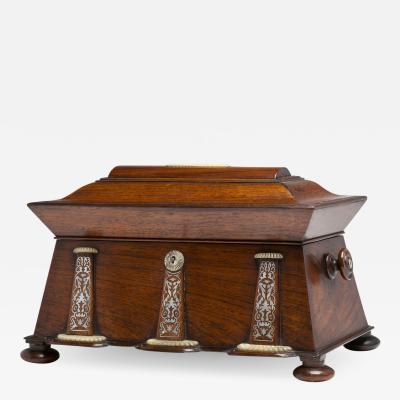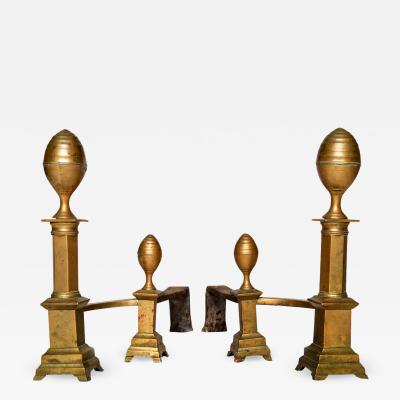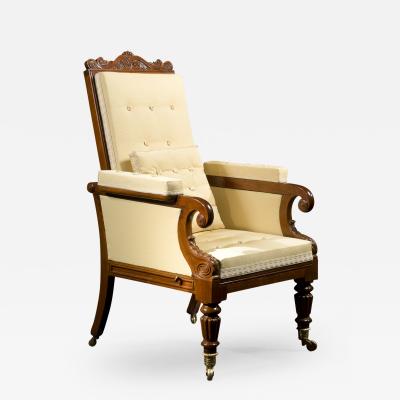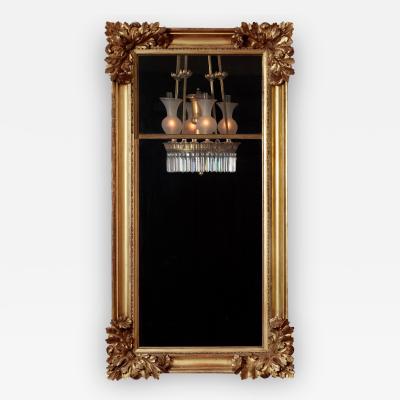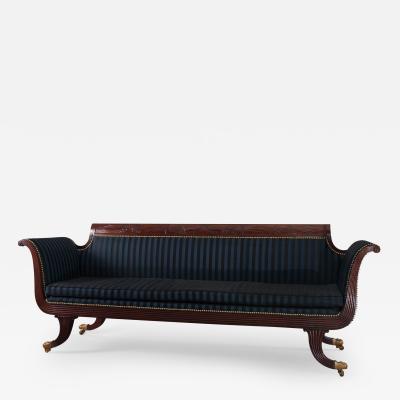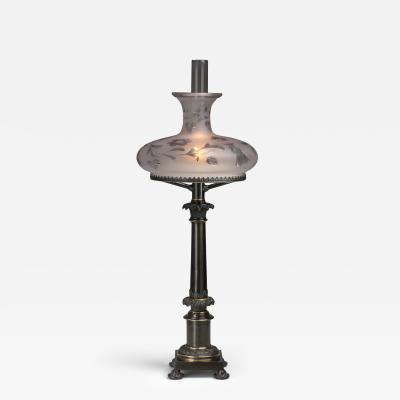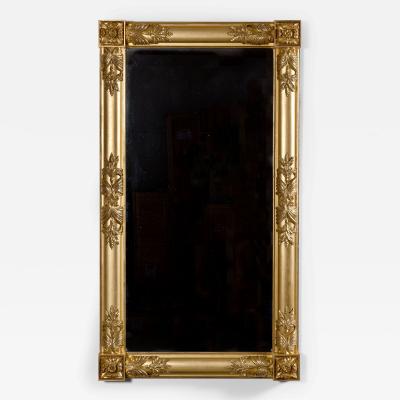Rare Restauration Mahogany Sofa Table
-
Description
RARE RESTAURATION MAHOGANY SOFA TABLE
Attributed to Duncan Phyfe and Sons (active 1837-1840)
or D. Phyfe & Son (1840-47)
New York, c.1840
The highly figured oblong top with short drop-leaves above a shallow case with two side-by-side drawers, a real and sham drawer on each side and bracket-shaped leaf supports terminating in rimmed disks that swing flush with the drawers on each side and end and fold flush with the case when the leaves are down, supported by a trestle base having flat sided, highly figured supports at each end that flair as they meet the block base, connected to each other by a plain flat-sided stretcher, the legs extending out perpendicular to the supports, tapering to an elliptic terminal with a conforming blocked and molded foot, raised on recessed casters. Secondary wood: Ash and White Pine
H: 30" W: 40" D: 26"
Condition: Excellent; This table survives in an almost perfect state of preservation with restoration only to tiny veneer chips along the bottom edges of the stretcher. Color has been restored to sun-bleached surfaces and it has been re-finished with shellac in the manner of the period.
Published: Peter M. Kenny and Michael K. Brown, Duncan Phyfe: Master Cabinetmaker in New York (New York: The Metropolitan Museum of Art, 2011), 240-41, pl. 51 and 96, fig. 116.
This table relates closely to a suite of Restauration furniture made by Phyfe in 1837 for Samuel A. Foot, a prominent New York attorney, which is now in the collection of the Metropolitan Museum of Art. It also relates closely to a group of furniture made by Phyfe for Governor John Lawrence Manning (1816-1890), at Milford Plantation in South Carolina in 1840-1841. An 1841 cellaret by D. Phyfe and Son at Milford has identical feet to the present table, (see also: Kenny & Brown, p. 258-9, pl. 60).
It also relates closely to a suite of furniture made in Phyfe's workshop in 1836 for Louisiana planter Lewis Sterling and his wife Sarah for their new Greek Revival plantation house "Wakefield." The suite, delivered in twenty-eight crates, included a pair of pier tables, a sideboard table, a dining table and as many as twelve bedsteads from the Phyfe shop. The legs of all the tables are virtually identical to those on the present sofa table. The Antiques article notes that the Stirling's also made purchases in New York from other furniture makers but pointedly observes, Phyfe's "Grecian plain furniture differs significantly from the exuberantly scrolled wares of his chief competitors..."
Another group of furniture documented to Phyfe by a bill of sale, made for New York attorney and judge, Benjamin F. Clark, in 1834, for his daughter Maria's wedding present, is also closely related. A pier table from the Clark suite is in the collection of the White House.
All of these pieces share Phyfe's distinctive plain rimmed convex disk boss that caps the volute of a scroll, and the convex elliptic-molded foot in use by the firm from 1834-41.
The French Restauration style of the Louis XVIII and Charles X period began to influence American furniture as early as the mid-1820's but did not become dominant until the 1830's. Phyfe's firm was the leading exponent of the style in the United States and working, in what has been described by scholar Thomas Gordon Smith as the "Grecian Plain Style," employing flat expanses of highly figured veneers without carving or ornament of any kind and relying on architectonic shapes, created some of the most sophisticated and refined furniture of his brilliant career.
In this piece, utilizing the richest veneers "book matched" on every surface, Phyfe has created a subtle symphony of form, shape, and texture unrivaled in the period.
Duncan Phyfe (1770-1854), considered the most important American cabinetmaker of the first half of the nineteenth century, worked at Partition Street (renamed Fulton Street in 1816) in New York City from 1793 through 1847. Famous and highly successful, Phyfe ran a large workshop and produced furniture throughout his long career in all the latest styles. As a fashion leader, Phyfe introduced New York to a succession of styles inspired by the renowned designers Robert Adam (1728-1792), George Hepplewhite (d.1786) and Thomas Sheraton (1751-1806) in England, and the Directoire, Empire and Restauration periods in France. His clients included the great merchant and banking elite of the city, as well as wealthy and discriminating buyers from Boston to New Orleans. An innovative designer, superior craftsman and carver, Phyfe’s name is synonymous with the finest New York furniture of the period. -
More Information
Documentation: Documented elsewhere (similar item) Origin: United States, New York Period: 19th Century Materials: Mahogany Condition: Excellent. Creation Date: c. 1835 Styles / Movements: Classical, William IV, Neoclassical Book References: Peter M. Kenny and Michael K. Brown, Duncan Phyfe: Master Cabinetmaker in New York (New York: The Metropolitan Museum of Art, 2011), 240-41, pl. 51 and 96, fig. 116. Dealer Reference #: T-S-061142 Incollect Reference #: 205183 -
Dimensions
W. 40 in; H. 30 in; D. 26 in; W. 101.6 cm; H. 76.2 cm; D. 66.04 cm; Open W. 59 in; Open W. 149.86 cm;
Message from Seller:
Welcome to Carswell Rush Berlin Antiques, a premier New York City-based dealer specializing in American antique furniture and decorative accessories from the Classical period (1800-1840). For inquiries, please contact us at 646.645.0404 or email carswellberlin@msn.com.



















